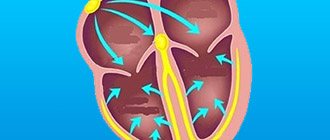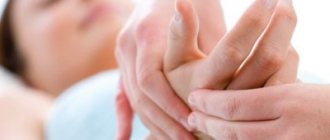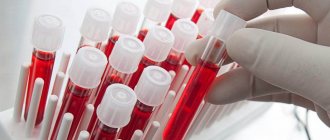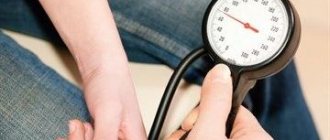Arrhythmia is a disturbance of the heart rhythm, which can be associated either with an increase or decrease in contractions per minute, or with deviations in the rhythm and synchrony of work. Symptoms of pathology can be recognized by chest pain, sudden weakness and other signs. At the first signs, the patient is recommended to consult a doctor and undergo diagnostics. In most cases, treatment involves the use of medications and lifestyle changes.
What is cardiac arrhythmia
The normal heart rate (i.e., the number of heartbeats per minute) depends primarily on the person’s age:
- at 30-40 years old, the normal frequency is 75-80 beats;
- at 40-60 years old 75-90 beats;
- at 60-80 years old 80-90 beats per minute.
Arrhythmia is a heart rhythm disorder that can manifest itself in different forms:
- change in heart rate;
- rhythm disturbance (above or below normal);
- disturbances in the sequence of contractions of the heart muscle.
Simply put, arrhythmia is any deviation of the heart rhythm from the average norm. In most cases, it speaks of disturbances in the functioning of the cardiovascular system.
Associated manifestations
Heart fluttering has a pathognomonic (typical, recognizable) sign
Heart fluttering can occur without any other symptoms, but most often when heart fluttering occurs, the symptoms accompanying such a sudden and very fast heartbeat are:
- decreased performance and physical endurance, general weakness;
- discomfort and feeling of squeezing in the chest;
- difficulty breathing such as shortness of breath;
- increased blood pressure;
- dizziness, attacks of nausea;
- at high heart rates – pre-fainting and loss of consciousness;
- frequent urination is possible.
Attacks of fluttering can last from a couple of tens of seconds to several days, and their frequency of occurrence is from once a year to many times during the day. Trembling can be triggered by physical and emotional stress, overheating of the body, excessive consumption of alcoholic beverages, drinking too much, and even intestinal disorders.
Please note that atrial flutter can be diagnosed not only at a high heart rate, but even at a pulse of 75-85 beats/min.
Important! The cost of ignoring the symptoms and not treating atrial flutter is heart failure, ventricular arrhythmias, stroke or renal infarction, intestinal ischemia, sudden vascular thrombosis, and paralysis of the lower or upper extremities.
Main causes of arrhythmia
There can be many factors leading to the development of this pathology. Moreover, even if a person leads a healthy lifestyle and regularly plays sports, he may experience rare attacks of heart palpitations. The most common reasons are lifestyle factors, including bad habits:
- unhealthy diet (fatty foods);
- as a consequence - obesity;
- excessive alcohol consumption;
- smoking;
- lack of sleep, sleep disturbances;
- uncontrolled use of certain types of medications;
- too intense physical activity.
Arrhythmia may also be associated with other reasons:
- pathologies and abnormalities of the cardiovascular system;
- Congenital heart defect;
- genetic factor (congenital anomalies, predisposition);
- diabetes;
- disorders of the thyroid gland;
- sinus node diseases;
- heart failure;
- vegetative-vascular dystonia.
Treatment of the disease
Only doctors, based on diagnostics and a comprehensive examination of the body, can make the correct conclusion - chest neurosis. Treatment methods differ depending on the course of the disease. They mean relieving pain and spasms, strengthening the nervous system, and improving blood circulation. There are several ways to treat intercostal neurosis:
- Blockade. It does not eliminate the main cause of neurosis, but this method allows you to relieve pain for several days. A blockade is done when non-steroidal anti-inflammatory drugs do not help.
- Injections. They are used only in extreme cases. For example, for radiculopathy, spinal pathologies and myelopathy, steroid injections are prescribed.
- Physiotherapy. It also relieves pain symptoms due to chest neurosis. This category includes electrophoresis, UHF and other thermal procedures. Doctors prescribe such treatment methods for incarceration, arthropathy and spondyloarthrosis.
- Training. To prevent and treat the disease, doctors recommend physical exercise. Among them are hyperextension, which serves to strengthen the back muscles, and stretching to relieve tension.
- Massage. This method helps relax muscles and also helps relieve pain. Massage is prescribed for the initial stage of intercostal neurosis, osteochondrosis, displacement of the vertebrae and spinal discs, as a preventive measure or as a method of treatment in combination with medications.
- Taking medications. B vitamins and ascorbic acid nourish nerve fibers with useful elements and strengthen the immune and nervous systems.
At the first sensation of pain, it is recommended to go to the doctor. This will allow you to prescribe timely treatment and eliminate the disease at the initial stage. Contacting a specialist will help you completely get rid of the disease. Save your health with I.G. Gernet is a psychotherapist with 20 years of experience!
To the list of articles
Other articles
- Throat neurosis: symptoms, treatment
- How to relieve a panic attack at home?
Symptoms of cardiac arrhythmia
The main symptoms of the pathology include the following:
- general weakness, appears suddenly;
- feeling of a strong heartbeat (“pounding” in the chest);
- sudden dizziness;
- headache of varying strength;
- attack of shortness of breath;
- chest pain of a compressive nature;
- in rare cases - episodic or regular loss of consciousness.
Some of the symptoms described are not specific. For example, patients often attribute headaches to psychological stress, and chest pain to severe physical exertion. Therefore, even if such signs rarely appear, it is better to consult a doctor for advice. Otherwise, the pathology can become irreversible, even leading to death, for example, due to myocardial infarction.
It is recommended to undergo diagnostics if at least one of the described deviations is present:
- insomnia;
- shortness of breath at night (a person wakes up in this state);
- noticeable, prolonged deterioration in general condition;
- frequent headaches;
- tremor (arms and/or legs shaking).
Symptoms of intercostal neurosis
Only a doctor can make a correct diagnosis after a complete examination of the body. However, characteristic symptoms that will help you recognize intercostal neurosis yourself are:
- voluntary twitching muscles;
- pain between the ribs, in the area of the shoulder blades and lower back;
- discomfort when coughing, sneezing and sudden movements. The pain may be sharp, dull or aching;
- numbness at the site of damage to nerve fibers;
- During palpation of the ribs, sternum and lumbar region, pain may intensify.
Neurosis of the ribs is similar in symptoms to diseases of the heart, stomach and lungs. But the main distinguishing symptom of this disease is constant aching pain, which can intensify with sudden movements, palpation, sneezing or coughing. No painkiller can relieve these painful sensations.
Diagnostics
Portable device for Holter-ECG
If your heart is fluttering, what should you do? Of course, go to the doctor and undergo the necessary tests.
To clarify the diagnosis and find out the causes of the disorder, the following types of examinations may be required:
- “classical” ElectroCG;
- carotid sinus massage test;
- 24-hour Holter ECG monitoring;
- transthoracic echocardiography;
- transesophageal echocardiography;
- rhythmocardiography;
- sphygmography;
- ECG according to the Sky;
- biochemical blood tests - for electrolytes and thyroid hormones;
- rheumatological screening;
- phonocardiography.
For your information. A Holter monitoring study is a continuous recording of an electrocardiogram, lasting from 1 to 7 days. Recording is carried out using a portable recorder, which is attached to a belt or a shoulder strap.
Causes of atrial flutter.
The most common cause is various types of disorders of the impulse conduction system due to the following diseases: - rheumatism (especially in the presence of mitral stenosis ( - coronary heart disease, - acute myocardial infarction, - arterial hypertension, - acute or chronic cor pulmonale, - idiopathic cardiomyopathies, - hyperthyroidism, - pericarditis, - myocarditis, - nonspecific chronic pulmonary diseases, - obstructive chronic pulmonary diseases, - atrial septal defect in adults, - WPW - syndrome (ventricular pre-excitation syndrome) - SSSU (sinus node dysfunction) or also called tachy syndrome - brady, - pathological (atypical) desympathy of the atria, - idiopathic variants. Pathogenetic significance of atrial flutter. The main pathological factor is the excessively high frequency of atrial contractions and all the resulting symptoms. Against the background of developing tachysystole, contractile diastolic dysfunction of the myocardium appears in the region of the left ventricle, which subsequently develops into contractile systolic dysfunction. Ultimately, this picture can develop into dilated cardiomyopathy and result in heart failure.
Symptoms of atrial flutter.
There are two forms of the disease: paroxysmal, that is, paroxysmal and constant. From here, two clinical pictures are distinguished:
Paroxysmal form of atrial flutter. With this form of the disease, the frequency of paroxysms, that is, attacks, ranges from one per year to several per day. The peculiarity of paroxysmal atrial flutter is that there is no age or gender category. Attacks can occur in both men and women of any age. But of course most often in people with myocardial disease. Paroxysms can occur against the background of physical or emotional stress, overeating, drinking alcohol, with a sharp drop in external temperature (immersion in cold water, going outside in winter, and so on) and even when drinking large amounts of water or stomach upsets. The patient often describes an attack of atrial flutter as a feeling of strong and rapid heartbeat that appears after some event or action. In more severe cases, dizziness, weakness, loss of consciousness and even short-term cardiac arrest are observed during an episode of atrial flutter with high-frequency conduction in the AV node (1:1). Persistent form of atrial flutter. This is a very dangerous form, since in the first stages of the development of the disease it is usually asymptomatic and manifests itself with the accumulation of consequences of a decrease in systemic blood output and arterial systemic pressure, which ultimately leads to a decrease in coronary blood flow. Typically, patients come to the doctor with already severe symptoms of heart failure.
Classification and mechanism of occurrence of disorders
In humans, the most common form of atrial flutter (typical) involves a single reentrant circuit with cycle activation in the right atrium around the tricuspid annulus (most often in a counterclockwise direction) with a region of slow conduction located between the tricuspid valve, the annulus, and the coronary sinus ostium (sub-Eustachian isthmus).
Typical counterclockwise atrial flutter has caudocranial activation (counterclockwise around the tricuspid annulus when viewed on a left anterior oblique fluoroscopic image) of the interatrial septum.
A typical AFL may also have a reverse activation sequence (clockwise around the tricuspid annulus). This option is much less common. When electrical activity moves clockwise, the electrocardiogram (ECG) will show positive flutter waves in leads II, III, and aVF, and they may appear somewhat sinusoidal. This arrhythmia is still considered to be a typical isthmus-dependent flutter. It is usually called reverse typical TP.
Atypical AFL is less studied and electroanatomically characterized. It can happen:
- from the right atrium as a result of surgical scars;
- from the left atrium, in particular from the pulmonary veins (focal entry site);
- from the mitral ring.
Left atrial flutter is a common complication after linear ablation procedures (for atrial fibrillation).










